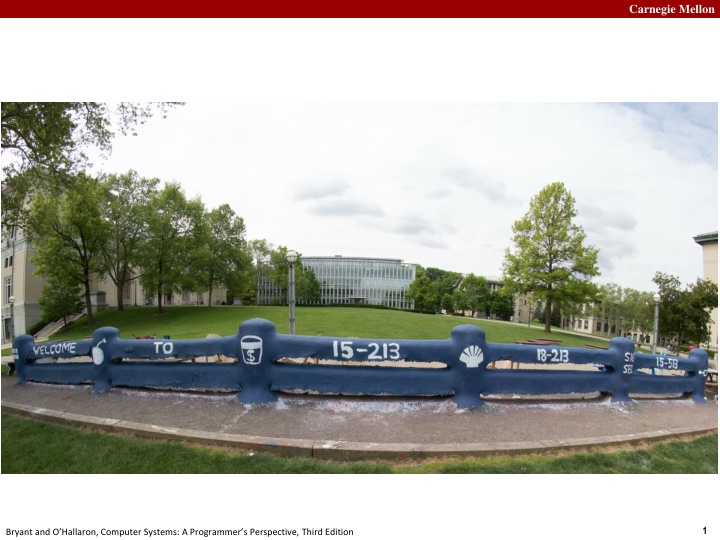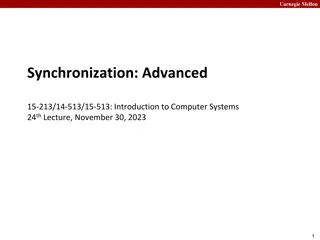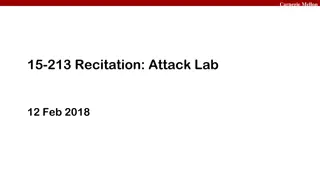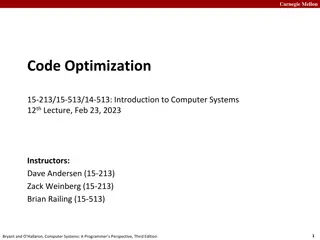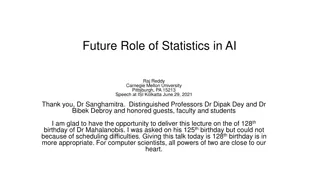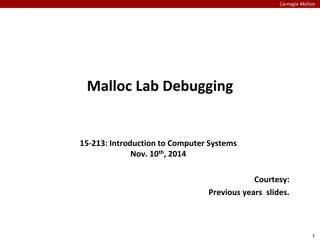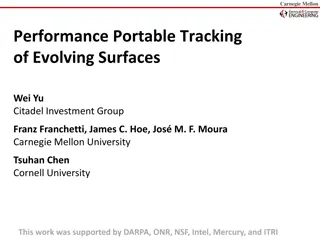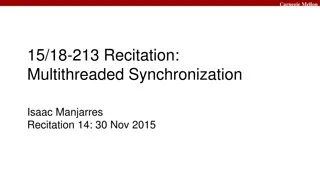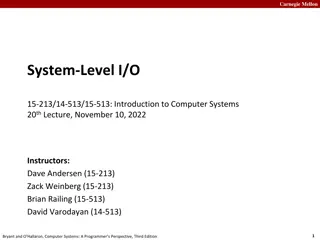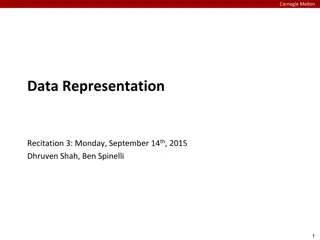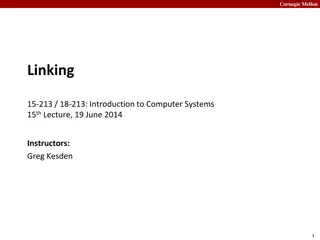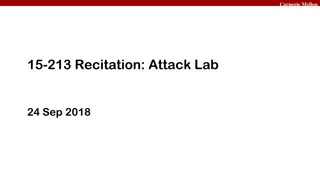Carnegie Mellon Computer Systems Overview
The content provides an overview of computer systems and network programming at Carnegie Mellon University. It covers topics such as client-server interactions, I/O handling, socket programming, and robust I/O practices. The lectures discuss concepts like TCP/IP communication, C Standard I/O, Unix I/O, RIO functions, and socket address structures. Students learn about client-server sessions, connection requests, data exchange, and error handling in programming. The content also highlights the importance of good coding practices and understanding computer system internals.
Download Presentation

Please find below an Image/Link to download the presentation.
The content on the website is provided AS IS for your information and personal use only. It may not be sold, licensed, or shared on other websites without obtaining consent from the author.If you encounter any issues during the download, it is possible that the publisher has removed the file from their server.
You are allowed to download the files provided on this website for personal or commercial use, subject to the condition that they are used lawfully. All files are the property of their respective owners.
The content on the website is provided AS IS for your information and personal use only. It may not be sold, licensed, or shared on other websites without obtaining consent from the author.
E N D
Presentation Transcript
Carnegie Mellon 1 Bryant and O Hallaron, Computer Systems: A Programmer s Perspective, Third Edition
Carnegie Mellon Network Programming: Part II 15-213/18-213/14-513/15-513/18-613: Introduction to Computer Systems 23rdLecture, November 12, 2019 2 Bryant and O Hallaron, Computer Systems: A Programmer s Perspective, Third Edition
Carnegie Mellon 2. Start client Client 1. Start server Server Review: Echo Server + Client Structure open_listenfd open_clientfd Connection request Await connection request from client accept 3. Exchange terminal read socket write socket read data Client / Server Session socket read terminal write socket write EOF socket read close 5. Drop client 4. Disconnect client close 3 Bryant and O Hallaron, Computer Systems: A Programmer s Perspective, Third Edition
Carnegie Mellon Review: C Standard I/O, Unix I/O and RIO Robust I/O (RIO): 15-213 special wrappers good coding practice: handles error checking, signals, and short counts fopen fdopen fread fwrite fscanf fprintf sscanf sprintf fgets fputs fflush fseek fclose C application program rio_readn rio_writen rio_readinitb rio_readlineb rio_readnb Standard I/O functions RIO functions open read write lseek stat close Unix I/O functions (accessed via system calls) 4 Bryant and O Hallaron, Computer Systems: A Programmer s Perspective, Third Edition
Carnegie Mellon 2. Start client Client 1. Start server Server Review: Echo Server + Client Structure open_listenfd open_clientfd Connection request Await connection request from client accept 3. Exchange fgets rio_writen rio_readlineb data Client / Server Session rio_readlineb fputs rio_writen EOF rio_readlineb close 5. Drop client 4. Disconnect client close 5 Bryant and O Hallaron, Computer Systems: A Programmer s Perspective, Third Edition
Carnegie Mellon Sockets Interface Client Server getaddrinfo getaddrinfo socket socket open_listenfd open_clientfd bind listen Connection request connect accept rio_writen rio_readlineb Client / Server Session Await connection request from next client rio_readlineb rio_writen EOF rio_readlineb close close 6 Bryant and O Hallaron, Computer Systems: A Programmer s Perspective, Third Edition
Carnegie Mellon Socket Address Structures & getaddrinfo Generic socket address: For address arguments to connect, bind, and accept Necessary only because C did not have generic (void *) pointers when the sockets interface was designed For casting convenience, we adopt the Stevens convention: typedef struct sockaddr SA; struct sockaddr { uint16_t sa_family; /* Protocol family */ char sa_data[14]; /* Address data. */ }; sa_family Family Specific getaddrinfo converts string representations of hostnames, host addresses, ports, service names to socket address structures 7 Bryant and O Hallaron, Computer Systems: A Programmer s Perspective, Third Edition
Carnegie Mellon Socket Address Structures Internet (IPv4) specific socket address: Must cast (struct sockaddr_in *) to (struct sockaddr *) for functions that take socket address arguments. struct sockaddr_in { uint16_t sin_family; /* Protocol family (always AF_INET) */ uint16_t sin_port; /* Port num in network byte order */ struct in_addr sin_addr; /* IP addr in network byte order */ unsigned char sin_zero[8]; /* Pad to sizeof(struct sockaddr) */ }; sin_addr sin_port 0 0 0 0 0 0 0 0 AF_INET sa_family sin_family Family Specific 8 Bryant and O Hallaron, Computer Systems: A Programmer s Perspective, Third Edition
Carnegie Mellon Sockets Interface Client Server getaddrinfo getaddrinfo SA list SA list socket socket open_listenfd open_clientfd bind listen Connection request connect accept rio_writen rio_readlineb Client / Server Session Await connection request from next client rio_readlineb rio_writen EOF rio_readlineb close close 9 Bryant and O Hallaron, Computer Systems: A Programmer s Perspective, Third Edition
Carnegie Mellon Sockets Interface: socket Clients and servers use the socket function to create a socket descriptor: int socket(int domain, int type, int protocol) Example: int clientfd = socket(AF_INET, SOCK_STREAM, 0); Indicates that we are using 32-bit IPV4 addresses Indicates that the socket will be the end point of a reliable (TCP) connection Protocol specific! Best practice is to use getaddrinfo to generate the parameters automatically, so that code is protocol independent. 10 Bryant and O Hallaron, Computer Systems: A Programmer s Perspective, Third Edition
Carnegie Mellon Sockets Interface Client Server getaddrinfo getaddrinfo SA list SA list socket socket open_listenfd listenfd clientfd open_clientfd bind listen Connection request connect accept rio_writen rio_readlineb Client / Server Session Await connection request from next client rio_readlineb rio_writen EOF rio_readlineb close close 11 Bryant and O Hallaron, Computer Systems: A Programmer s Perspective, Third Edition
Carnegie Mellon Sockets Interface: bind A server uses bind to ask the kernel to associate the server s socket address with a socket descriptor: int bind(int sockfd, SA *addr, socklen_t addrlen); Recall:typedef struct sockaddr SA; Process can read bytes that arrive on the connection whose endpoint is addr by reading from descriptor sockfd Similarly, writes to sockfd are transferred along connection whose endpoint is addr 12 Bryant and O Hallaron, Computer Systems: A Programmer s Perspective, Third Edition
Carnegie Mellon Sockets Interface Client Server getaddrinfo getaddrinfo SA list SA list socket socket open_listenfd listenfd clientfd open_clientfd bind listenfd <-> SA listen Connection request connect accept rio_writen rio_readlineb Client / Server Session Await connection request from next client rio_readlineb rio_writen EOF rio_readlineb close close 14 Bryant and O Hallaron, Computer Systems: A Programmer s Perspective, Third Edition
Carnegie Mellon Sockets Interface: listen Kernel assumes that descriptor from socket function is an active socket that will be on the client end A server calls the listen function to tell the kernel that a descriptor will be used by a server rather than a client: int listen(int sockfd, int backlog); Converts sockfd from an active socket to a listening socket that can accept connection requests from clients. backlog is a hint about the number of outstanding connection requests that the kernel should queue up before starting to refuse requests (128-ish by default) 15 Bryant and O Hallaron, Computer Systems: A Programmer s Perspective, Third Edition
Carnegie Mellon Sockets Interface Client Server getaddrinfo getaddrinfo SA list SA list socket socket open_listenfd listenfd clientfd open_clientfd bind listenfd <-> SA listen Connection request listening listenfd connect accept rio_writen rio_readlineb Client / Server Session Await connection request from next client rio_readlineb rio_writen EOF rio_readlineb close close 16 Bryant and O Hallaron, Computer Systems: A Programmer s Perspective, Third Edition
Carnegie Mellon Sockets Interface: accept Servers wait for connection requests from clients by calling accept: int accept(int listenfd, SA *addr, int *addrlen); Waits for connection request to arrive on the connection bound to listenfd, then fills in client s socket address in addr and size of the socket address in addrlen. Returns a connected descriptor that can be used to communicate with the client via Unix I/O routines. 17 Bryant and O Hallaron, Computer Systems: A Programmer s Perspective, Third Edition
Carnegie Mellon Sockets Interface Client Server getaddrinfo getaddrinfo SA list SA list socket socket open_listenfd listenfd clientfd open_clientfd bind listenfd <-> SA listen Connection request listening listenfd connect accept rio_writen rio_readlineb Client / Server Session Await connection request from next client rio_readlineb rio_writen EOF rio_readlineb close close 18 Bryant and O Hallaron, Computer Systems: A Programmer s Perspective, Third Edition
Carnegie Mellon Sockets Interface: connect A client establishes a connection with a server by calling connect: int connect(int clientfd, SA *addr, socklen_t addrlen); Attempts to establish a connection with server at socket address addr If successful, then clientfd is now ready for reading and writing. Resulting connection is characterized by socket pair (x:y, addr.sin_addr:addr.sin_port) x is client address y is ephemeral port that uniquely identifies client process on client host Best practice is to use getaddrinfo to supply the arguments addr and addrlen. 19 Bryant and O Hallaron, Computer Systems: A Programmer s Perspective, Third Edition
Carnegie Mellon connect/accept Illustrated listenfd(3) 1. Server blocks in accept, waiting for connection request on listening descriptor listenfd Client Server clientfd Connection request listenfd(3) 2. Client makes connection request by calling and blocking in connect Client Server clientfd listenfd(3) 3. Server returns connfd from accept. Client returns from connect. Connection is now established between clientfd and connfd Client Server clientfd connfd(4) 20 Bryant and O Hallaron, Computer Systems: A Programmer s Perspective, Third Edition
Carnegie Mellon Connected vs. Listening Descriptors Listening descriptor End point for client connection requests Created once and exists for lifetime of the server Connected descriptor End point of the connection between client and server A new descriptor is created each time the server accepts a connection request from a client Exists only as long as it takes to service client Why the distinction? Allows for concurrent servers that can communicate over many client connections simultaneously E.g., Each time we receive a new request, we fork a child to handle the request 21 Bryant and O Hallaron, Computer Systems: A Programmer s Perspective, Third Edition
Carnegie Mellon Sockets Interface Client Server getaddrinfo getaddrinfo SA list SA list socket socket open_listenfd listenfd clientfd open_clientfd bind listenfd <-> SA listen Connection request listening listenfd connect accept connected (to SA) clientfd connected connfd rio_writen rio_readlineb Client / Server Session Await connection request from next client rio_readlineb rio_writen EOF rio_readlineb close close 22 Bryant and O Hallaron, Computer Systems: A Programmer s Perspective, Third Edition
Carnegie Mellon Sockets Interface Client Server getaddrinfo getaddrinfo socket socket open_listenfd open_clientfd bind listen Connection request connect accept rio_writen rio_readlineb Client / Server Session Await connection request from next client rio_readlineb rio_writen EOF rio_readlineb close close 23 Bryant and O Hallaron, Computer Systems: A Programmer s Perspective, Third Edition
Carnegie Mellon Sockets Helper: open_clientfd Establish a connection with a server int open_clientfd(char *hostname, char *port) { int clientfd; struct addrinfo hints, *listp, *p; /* Get a list of potential server addresses */ memset(&hints, 0, sizeof(struct addrinfo)); hints.ai_socktype = SOCK_STREAM; /* Open a connection */ hints.ai_flags = AI_NUMERICSERV; /* using numeric port arg. */ hints.ai_flags |= AI_ADDRCONFIG; /* Recommended for connections */ Getaddrinfo(hostname, port, &hints, &listp); csapp.c AI_ADDRCONFIG uses your system s address type. You have at least one IPV4 iface? IPV4. At least one IPV6? IPV6. 24 Bryant and O Hallaron, Computer Systems: A Programmer s Perspective, Third Edition
Carnegie Mellon Review: getaddrinfo Linked List addrinfo structs result Socket address structs ai_canonname ai_addr ai_next NULL ai_addr ai_next NULL ai_addr NULL Clients: walk this list, trying each socket address in turn, until the calls to socket and connect succeed. Servers: walk the list until calls to socket and bind succeed. 25 Bryant and O Hallaron, Computer Systems: A Programmer s Perspective, Third Edition
Carnegie Mellon Sockets Helper: open_clientfd (cont) /* Walk the list for one that we can successfully connect to */ for (p = listp; p; p = p->ai_next) { /* Create a socket descriptor */ if ((clientfd = socket(p->ai_family, p->ai_socktype, p->ai_protocol)) < 0) continue; /* Socket failed, try the next */ /* Connect to the server */ if (connect(clientfd, p->ai_addr, p->ai_addrlen) != -1) break; /* Success */ Close(clientfd); /* Connect failed, try another */ } /* Clean up */ Freeaddrinfo(listp); if (!p) /* All connects failed */ return -1; else /* The last connect succeeded */ return clientfd; } csapp.c 26 Bryant and O Hallaron, Computer Systems: A Programmer s Perspective, Third Edition
Carnegie Mellon Sockets Interface Client Server getaddrinfo getaddrinfo socket socket open_listenfd open_clientfd bind listen Connection request connect accept rio_writen rio_readlineb Client / Server Session Await connection request from next client rio_readlineb rio_writen EOF rio_readlineb close close 27 Bryant and O Hallaron, Computer Systems: A Programmer s Perspective, Third Edition
Carnegie Mellon Sockets Helper: open_listenfd Create a listening descriptor that can be used to accept connection requests from clients. int open_listenfd(char *port) { struct addrinfo hints, *listp, *p; int listenfd, optval=1; /* Get a list of potential server addresses */ memset(&hints, 0, sizeof(struct addrinfo)); hints.ai_socktype = SOCK_STREAM; /* Accept connect. */ hints.ai_flags = AI_PASSIVE | AI_ADDRCONFIG; /* on any IP addr */ hints.ai_flags |= AI_NUMERICSERV; /* using port no. */ Getaddrinfo(NULL, port, &hints, &listp); csapp.c 28 Bryant and O Hallaron, Computer Systems: A Programmer s Perspective, Third Edition
Carnegie Mellon Sockets Helper: open_listenfd (cont) /* Walk the list for one that we can bind to */ for (p = listp; p; p = p->ai_next) { /* Create a socket descriptor */ if ((listenfd = socket(p->ai_family, p->ai_socktype, p->ai_protocol)) < 0) continue; /* Socket failed, try the next */ /* Eliminates "Address already in use" error from bind */ Setsockopt(listenfd, SOL_SOCKET, SO_REUSEADDR, (const void *)&optval , sizeof(int)); /* Bind the descriptor to the address */ if (bind(listenfd, p->ai_addr, p->ai_addrlen) == 0) break; /* Success */ Close(listenfd); /* Bind failed, try the next */ } csapp.c 29 Bryant and O Hallaron, Computer Systems: A Programmer s Perspective, Third Edition
Carnegie Mellon Sockets Helper: open_listenfd (cont) /* Clean up */ Freeaddrinfo(listp); if (!p) /* No address worked */ return -1; /* Make it a listening socket ready to accept conn. requests */ if (listen(listenfd, LISTENQ) < 0) { Close(listenfd); return -1; } return listenfd; } csapp.c Key point: open_clientfd and open_listenfd are both independent of any particular version of IP. 30 Bryant and O Hallaron, Computer Systems: A Programmer s Perspective, Third Edition
Carnegie Mellon Testing Servers Using telnet The telnet program is invaluable for testing servers that transmit ASCII strings over Internet connections Our simple echo server Web servers Mail servers Usage: linux> telnet <host> <portnumber> Creates a connection with a server running on <host>and listening on port <portnumber> 31 Bryant and O Hallaron, Computer Systems: A Programmer s Perspective, Third Edition
Carnegie Mellon Testing the Echo Server With telnet whaleshark> ./echoserveri 15213 Connected to (MAKOSHARK.ICS.CS.CMU.EDU, 50280) server received 11 bytes server received 8 bytes makoshark> telnet whaleshark.ics.cs.cmu.edu 15213 Trying 128.2.210.175... Connected to whaleshark.ics.cs.cmu.edu (128.2.210.175). Escape character is '^]'. Hi there! Hi there! Howdy! Howdy! ^] telnet> quit Connection closed. makoshark> 32 Bryant and O Hallaron, Computer Systems: A Programmer s Perspective, Third Edition
Carnegie Mellon Web Server Basics HTTP request Clients and servers communicate using the HyperText Transfer Protocol (HTTP) Client and server establish TCP connection Client requests content Server responds with requested content Client and server close connection (eventually) Web client (browser) Web server HTTP response (content) HTTP Web content TCP Streams Current version is HTTP/1.1 RFC 2616, June, 1999. IP Datagrams http://www.w3.org/Protocols/rfc2616/rfc2616.html 33 Bryant and O Hallaron, Computer Systems: A Programmer s Perspective, Third Edition
Carnegie Mellon Web Content Web servers return content to clients content: a sequence of bytes with an associated MIME (Multipurpose Internet Mail Extensions) type Example MIME types text/html text/plain image/gif image/png image/jpeg HTML document Unformatted text Binary image encoded in GIF format Binary image encoded in PNG format Binary image encoded in JPEG format You can find the complete list of MIME types at: http://www.iana.org/assignments/media-types/media-types.xhtml 34 Bryant and O Hallaron, Computer Systems: A Programmer s Perspective, Third Edition
Carnegie Mellon Static and Dynamic Content The content returned in HTTP responses can be either static or dynamic Static content: content stored in files and retrieved in response to an HTTP request Examples: HTML files, images, audio clips, Javascript programs Request identifies which content file Dynamic content: content produced on-the-fly in response to an HTTP request Example: content produced by a program executed by the server on behalf of the client Request identifies file containing executable code Web content associated with a file that is managed by the server 35 Bryant and O Hallaron, Computer Systems: A Programmer s Perspective, Third Edition
Carnegie Mellon URLs and how clients and servers use them Unique name for a file: URL (Universal Resource Locator) Example URL: http://www.cmu.edu:80/index.html Clients use prefix (http://www.cmu.edu:80) to infer: What kind (protocol) of server to contact (HTTP) Where the server is (www.cmu.edu) What port it is listening on (80) Servers use suffix (/index.html) to: Determine if request is for static or dynamic content. No hard and fast rules for this One convention: executables reside in cgi-bindirectory Find file on file system Initial / in suffix denotes home directory for requested content. Minimal suffix is / , which server expands to configured default filename (usually, index.html) 36 Bryant and O Hallaron, Computer Systems: A Programmer s Perspective, Third Edition
Carnegie Mellon HTTP Requests HTTP request is a request line, followed by zero or more request headers Request line: <method> <uri> <version> <method> is one of GET, POST, OPTIONS, HEAD, PUT, DELETE, orTRACE <uri>is typically URL for proxies, URL suffix for servers A URL is a type of URI (Uniform Resource Identifier) See http://www.ietf.org/rfc/rfc2396.txt <version>is HTTP version of request (HTTP/1.0 or HTTP/1.1) Request headers: <header name>: <header data> Provide additional information to the server 37 Bryant and O Hallaron, Computer Systems: A Programmer s Perspective, Third Edition
Carnegie Mellon HTTP Responses HTTP response is a response line followed by zero or more response headers, possibly followed by content, with blank line ( \r\n ) separating headers from content. Response line: <version> <status code> <status msg> <version> is HTTP version of the response <status code> is numeric status <status msg> is corresponding English text 200 OK Request was handled without error 301 Moved Provide alternate URL 404 Not found Server couldn t find the file Response headers: <header name>: <header data> Provide additional information about response Content-Type: MIME type of content in response body Content-Length: Length of content in response body 38 Bryant and O Hallaron, Computer Systems: A Programmer s Perspective, Third Edition
Carnegie Mellon Example HTTP Transaction whaleshark> telnet www.cmu.edu 80 Client: open connection to server Trying 128.2.42.52... Telnet prints 3 lines to terminal Connected to WWW-CMU-PROD-VIP.ANDREW.cmu.edu. Escape character is '^]'. GET / HTTP/1.1 Client: request line Host: www.cmu.edu Client: required HTTP/1.1 header Client: empty line terminates headers HTTP/1.1 301 Moved Permanently Server: response line Date: Wed, 05 Nov 2014 17:05:11 GMT Server: followed by 5 response headers Server: Apache/1.3.42 (Unix) Server: this is an Apache server Location: http://www.cmu.edu/index.shtml Server: page has moved here Transfer-Encoding: chunked Server: response body will be chunked Content-Type: text/html; charset=... Server: expect HTML in response body Server: empty line terminates headers 15c Server: first line in response body <HTML><HEAD> Server: start of HTML content </BODY></HTML> Server: end of HTML content 0 Server: last line in response body Connection closed by foreign host. Server: closes connection HTTP standard requires that each text line end with \r\n Blank line ( \r\n ) terminates request and response headers 39 Bryant and O Hallaron, Computer Systems: A Programmer s Perspective, Third Edition
Carnegie Mellon Example HTTP Transaction, Take 2 whaleshark> telnet www.cmu.edu 80 Client: open connection to server Trying 128.2.42.52... Telnet prints 3 lines to terminal Connected to WWW-CMU-PROD-VIP.ANDREW.cmu.edu. Escape character is '^]'. GET /index.shtml HTTP/1.1 Client: request line Host: www.cmu.edu Client: required HTTP/1.1 header Client: empty line terminates headers HTTP/1.1 200 OK Server: response line Date: Wed, 05 Nov 2014 17:37:26 GMT Server: followed by 4 response headers Server: Apache/1.3.42 (Unix) Transfer-Encoding: chunked Content-Type: text/html; charset=... Server: empty line terminates headers 1000 Server: begin response body <html ..> Server: first line of HTML content </html> 0 Server: end response body Connection closed by foreign host. Server: close connection 40 Bryant and O Hallaron, Computer Systems: A Programmer s Perspective, Third Edition
Carnegie Mellon Example HTTP(S) Transaction, Take 3 whaleshark> openssl s_client www.cs.cmu.edu:443 CONNECTED(00000005) Certificate chain - Server certificate -----BEGIN CERTIFICATE----- MIIGDjCCBPagAwIBAgIRAMiF7LBPDoySilnNoU+mp+gwDQYJKoZIhvcNAQELBQAw djELMAkGA1UEBhMCVVMxCzAJBgNVBAgTAk1JMRIwEAYDVQQHEwlBbm4gQXJib3Ix EjAQBgNVBAoTCUludGVybmV0MjERMA8GA1UECxMISW5Db21tb24xHzAdBgNVBAMT wkWkvDVBBCwKXrShVxQNsj6J -----END CERTIFICATE----- subject=/C=US/postalCode=15213/ST=PA/L=Pittsburgh/street=5000 Forbes Ave/O=Carnegie Mellon University/OU=School of Computer Science/CN=www.cs.cmu.edu issuer=/C=US/ST=MI/L=Ann Arbor/O=Internet2/OU=InCommon/CN=InCommon RSA Server CA SSL handshake has read 6274 bytes and written 483 bytes >GET / HTTP/1.0 HTTP/1.1 200 OK Date: Tue, 12 Nov 2019 04:22:15 GMT Server: Apache/2.4.10 (Ubuntu) Set-Cookie: SHIBLOCATION=scsweb; path=/; domain=.cs.cmu.edu 41 Bryant and O Hallaron, Computer Systems: A Programmer s Perspective, Third Edition ... HTML Content Continues Below ...
Carnegie Mellon Quiz Time! Check out: https://canvas.cmu.edu/courses/10968 42 Bryant and O Hallaron, Computer Systems: A Programmer s Perspective, Third Edition
Carnegie Mellon Tiny Web Server Tiny Web server described in text Tiny is a sequential Web server Serves static and dynamic content to real browsers text files, HTML files, GIF, PNG, and JPEG images 239 lines of commented C code Not as complete or robust as a real Web server You can break it with poorly-formed HTTP requests (e.g., terminate lines with \n instead of \r\n ) 43 Bryant and O Hallaron, Computer Systems: A Programmer s Perspective, Third Edition
Carnegie Mellon Tiny Operation Accept connection from client Read request from client (via connected socket) Split into <method> <uri> <version> If method not GET, then return error If URI contains cgi-bin then serve dynamic content (Would do wrong thing if had file abcgi-bingo.html ) Fork process to execute program Otherwise serve static content Copy file to output 44 Bryant and O Hallaron, Computer Systems: A Programmer s Perspective, Third Edition
Carnegie Mellon Tiny Serving Static Content void serve_static(int fd, char *filename, int filesize) { int srcfd; char *srcp, filetype[MAXLINE], buf[MAXBUF]; /* Send response headers to client */ get_filetype(filename, filetype); sprintf(buf, "HTTP/1.0 200 OK\r\n"); sprintf(buf, "%sServer: Tiny Web Server\r\n", buf); sprintf(buf, "%sConnection: close\r\n", buf); sprintf(buf, "%sContent-length: %d\r\n", buf, filesize); sprintf(buf, "%sContent-type: %s\r\n\r\n", buf, filetype); Rio_writen(fd, buf, strlen(buf)); /* Send response body to client */ srcfd = Open(filename, O_RDONLY, 0); srcp = Mmap(0, filesize, PROT_READ, MAP_PRIVATE, srcfd, 0); Close(srcfd); Rio_writen(fd, srcp, filesize); Munmap(srcp, filesize); } tiny.c 45 Bryant and O Hallaron, Computer Systems: A Programmer s Perspective, Third Edition
Carnegie Mellon Serving Dynamic Content Client sends request to server GET /cgi-bin/env.pl HTTP/1.1 If request URI contains the string /cgi-bin , the Tiny server assumes that the request is for dynamic content Client Server 46 Bryant and O Hallaron, Computer Systems: A Programmer s Perspective, Third Edition
Carnegie Mellon Serving Dynamic Content (cont) The server creates a child process and runs the program identified by the URI in that process Client Server fork/exec env.pl 47 Bryant and O Hallaron, Computer Systems: A Programmer s Perspective, Third Edition
Carnegie Mellon Serving Dynamic Content (cont) The child runs and generates the dynamic content Client Server Content Content The server captures the content of the child and forwards it without modification to the client env.pl 48 Bryant and O Hallaron, Computer Systems: A Programmer s Perspective, Third Edition
Carnegie Mellon Issues in Serving Dynamic Content How does the client pass program arguments to the server? Request Content Client Server How does the server pass these arguments to the child? Content Create How does the server pass other info relevant to the request to the child? env.pl How does the server capture the content produced by the child? These issues are addressed by the Common Gateway Interface (CGI) specification. 49 Bryant and O Hallaron, Computer Systems: A Programmer s Perspective, Third Edition
Carnegie Mellon CGI Because the children are written according to the CGI spec, they are often called CGI programs. However, CGI really defines a simple standard for transferring information between the client (browser), the server, and the child process. CGI is the original standard for generating dynamic content. Has been largely replaced by other, faster techniques: E.g., fastCGI, Apache modules, Java servlets, Rails controllers Avoid having to create process on the fly (expensive and slow). 50 Bryant and O Hallaron, Computer Systems: A Programmer s Perspective, Third Edition
Carnegie Mellon The add.com Experience host port CGI program arguments Output page 51 Bryant and O Hallaron, Computer Systems: A Programmer s Perspective, Third Edition
